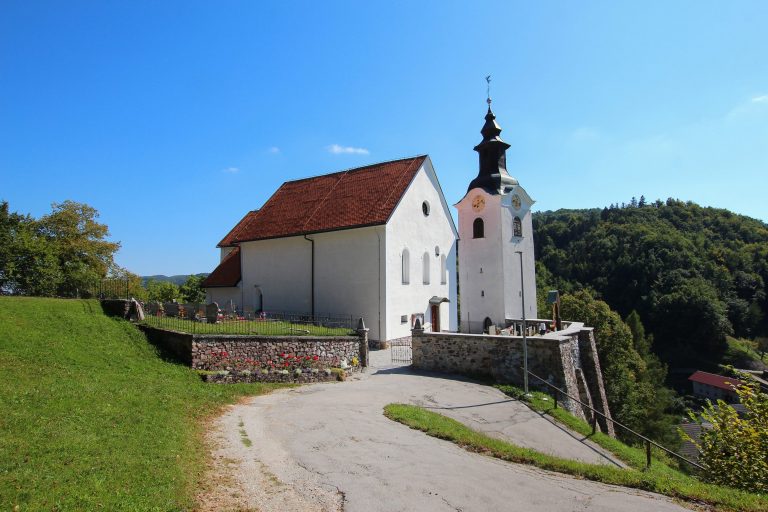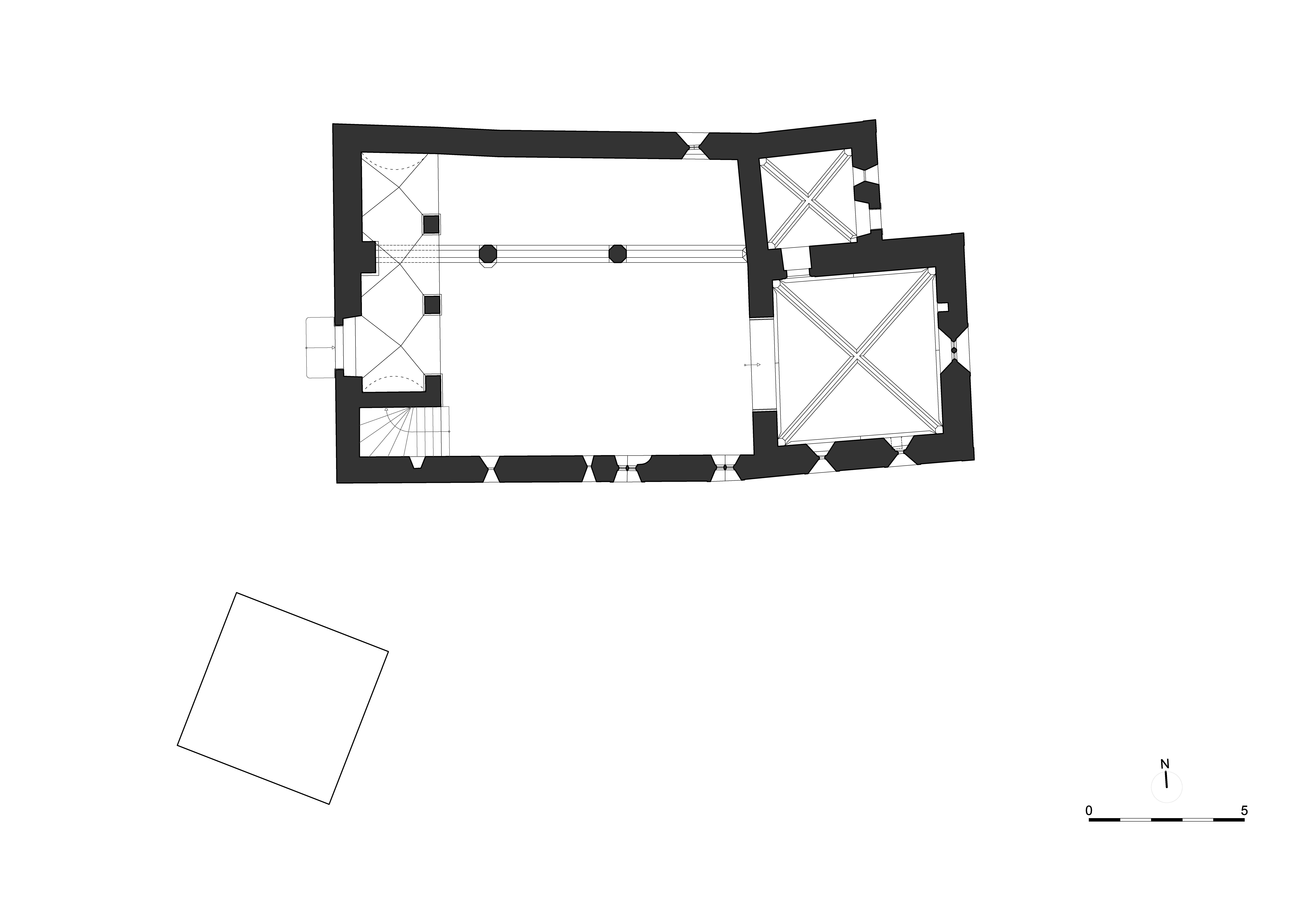List of paintings

The settlement of Svibno (Schärffenberg) was first mentioned in the second half of the 12th century (according to a later transcription of a document from 1169) and as the seat of the parish in 1286. The parish probably developed from the former church owned by the Lords of Svibno (Schärffenberg) – the ruins of their castle are located on the hill above the church – while the dedication to the Holy Cross was documented as early as in 1319. The church originally belonged to the ancient parish of Laško and the Savinja archdeaconate but lost its connection with Styria when it was annexed to the newly established diocese of Ljubljana in 1461. In 1382, the ownership of the seigniory and thus the patronage of the church passed from the Lords of Svibno to the Habsburgs.[1] In the Middle Ages, Svibno had the status of a market town, which it lost in the Early Modern Period.[2]
________________________________________
[1] HÖFLER 2001, p. 178; KOS 2003, pp. 53–61; HÖFLER 2017, p. 199; Historična topografija 2021, pp. 1435–1449. According to older literature, the estate was taken over by the Counts of Cilli; see CURK 1981, p. 80; KOROPEC 1981, p. 55.
[2] GOLEC 2019, pp. 374–378.
The church, correctly oriented towards the east, is still Romanesque at its core. As a single-nave church with a flat ceiling and an archaeologically evidenced semi-circular apse, it was probably erected as early as in the 12th century.[1] From this stage, the nave part with a pair of semi-circular windows in the southern wall has been partially preserved. In the transitional period from the Romanesque to the Gothic period, the apse was replaced with a square rib-vaulted chancel, while a somewhat smaller sacristy was added on the northern side. The time of this crucial alteration is not entirely clear, but more recent research places it in the middle of the 13th century.[2] As the building had to be adapted to the terrain – the church stands on a partly artificial terrace next to the castle hill – its floor plan is somewhat irregular and the eastern part of the church is slightly offset. Around 1400 or the beginning of the 15th century, the church was enlarged as the northern nave, which continues the line of the sacristy, was added.[3] The only known information related to the medieval church is an inscription with the year 1324, known only from transcriptions, which various researchers have associated with the various stages of alterations. However, more recent research has called the inscription into question.[4] On the southern side, the church features a freestanding belfry, constructed on the site of a former castle defence tower. The two naves were not vaulted until around 1900 when the window openings were also altered or added.[5] During the renovation in the 1980s and 1990s, the medieval stage with a flat wooden ceiling was reconstructed.[6]
________________________________________
[1] BUTINA, BRIŠNIK 2010, pp. 354–355.
[2] OTER GORENČIČ 2007, pp. 499.
[3] STOPAR 1981, pp. 15–16; HÖFLER 2001, p. 178.
[4] About the possibility that the inscription was transcribed erroneously and the year was actually 1524, see KOS 2003, p. 58. About the complex problem of reconstructing the architectural history of the Svibno church, see OTER GORENČIČ 2007, pp. 497–502.
[5] STOPAR 1981, p. 10.
[6] See the Restoration and renovation interventions section.
According to Marijan Zadnikar’s reports, in 1952, at least the second layer of the murals was visible above the nave ceiling.[1] In 1959, he suggested that the church, although much older, had not been painted before 1400.[2] During the conservation and restoration works in the second half of the 1970s, Ivan Stopar dated the oldest layer approximately to the 14th century.[3] Around this time, the church was also examined by Jože Curk, who saw the layer of murals from the early 14th century in the nave and the chancel.[4] Tanja Zimmermann did not include the murals in her dissertation on the 13th– and 14th-century mural painting in Slovenia. Thus, Janez Höfler was the first to contribute a stylistic analysis. By dating the oldest stage of the murals to the middle of the 13th century or shortly after, he identified them as one of the oldest examples of medieval mural painting in Slovenia.[5]
BADOVINAC 2006
Bogdan BADOVINAC, Svibno – cerkev sv. Križa, Varstvo spomenikov. Poročila, 39–41, 2006, p. 202.
BUTINA, BRIŠNIK 2010
Eva BUTINA, Danijela BRIŠNIK, Svibno – cerkev Poveličanja sv. Križa, Varstvo spomenikov. Poročila, 46, 2010, pp. 354–355.
CURK 1981
Jože CURK, Radeče in njihova okolica. Gradbeno-zgodovinska skica, Časopis za zgodovino in narodopisje, n. s. 15, 1979 (=50/1–2), 1981, pp. 78–114.
GOLEC 2019
Boris GOLEC, Extinct Medieval Boroughs in Southern Slovenia, Annales. Anali za istrske in mediteranske študije. Series Historia et Sociologia, 29/3, 2019, pp. 373–392.
Historična topografija 2021
Historična topografija Kranjske (do leta 1500), Ljubljana 20212 (Slovenska historična topografija, 1), https://topografija.zrc-sazu.si/sht/files/SHT-Kranjska_web2.0.pdf.
HÖFLER 2001
Janez HÖFLER, Srednjeveške freske v Sloveniji. 3: Okolica Ljubljane z Notranjsko, Dolenjsko in Belo krajino, Ljubljana 2001.
HÖFLER 2017
Janez HÖFLER, Gradivo za historično topografijo predjožefinskih župnij na Slovenskem. Kranjska, Ljubljana 20172, http://www.viharnik.com/content.php?IDb=89.
KOROPEC 1981
Jože KOROPEC, Žebnik, Radeče in Svibno do 17. stoletja, Časopis za zgodovino in narodopisje, n. s. 15, 1979 (=50/1–2), 1981, pp. 51–77.
KOS 2003
Dušan KOS, Blesk zlate krone. Gospodje Svibenski – kratka zgodovina plemenitih nasilnikov, Ljubljana 2003.
OTER GORENČIČ 2007
Mija OTER GORENČIČ, Romanska in zgodnjegotska arhitekturna plastika na Slovenskem, Ljubljana 2007 (doctoral dissertation typescript).
PESKAR 1991
Robert PESKAR, Srednjeveške poslikave zunanjščin cerkva v osrednji Sloveniji, Ljubljana 1991 (doctoral dissertation typescript).
STOPAR 1965
Ivan STOPAR, Svibno pri Radečah, Varstvo spomenikov, 9/1962–1964, 1965, p. 243.
STOPAR 1967
Ivan STOPAR, Svibno pri Radečah, Varstvo spomenikov, 11/1966, 1967, p. 161.
STOPAR 1975
Ivan STOPAR, Svibno pri Radečah, Varstvo spomenikov, 17–19/2, 1975, p. 154.
STOPAR 1979
Ivan STOPAR, Svibno pri Radečah, Varstvo spomenikov, 22, 1979, pp. 366–367.
STOPAR 1981
Ivan STOPAR, K problematiki t. i. “laške skupine”. Razmišljanja ob novih stavbnozgodovinskih odkritjih, Zbornik za umetnostno zgodovino, n. s. 17, 1981, pp. 9–31.
STOPAR 1982
Ivan STOPAR, Svibno pri Radečah, Varstvo spomenikov, 24, 1982, p. 230
STOPAR 1987
Ivan STOPAR, Svibno pri Radečah, Varstvo spomenikov, 29, 1987, p. 348
STOPAR 1989
Ivan STOPAR, Svibno pri Radečah, Varstvo spomenikov, 31, 1989, p. 334.
ZADNIKAR 1982
Marijan ZADNIKAR, Romanika v Sloveniji. Tipologija in morfologija sakralne arhitekture, Ljubljana 1982.
ZIMMERMANN 1996
Tanja ZIMMERMANN, Stensko slikarstvo poznega 13. in 14. stoletja na Slovenskem, Ljubljana 1996 (doctoral dissertation typescript).
________________________________________
[1] Informacijsko-dokumentacijski center za dediščino Ministrstva za kulturo Republike Slovenije, Ljubljana, Zapiski Marijana Zadnikarja, Svibno, 1952, http://www.eheritage.si/MK_Zapiski/z002-1138.pdf.
[2] Informacijsko-dokumentacijski center za dediščino Ministrstva za kulturo Republike Slovenije, Ljubljana, Zapiski Marijana Zadnikarja, Svibno, 1959, http://www.eheritage.si/MK_Zapiski/z002-1138.pdf.
[3] STOPAR 1979, p. 367.
[4] CURK 1981, pp. 105–106.
[5] HÖFLER 2001, pp. 178–183.
The first conservation and restoration interventions date back to the 1960s.[1] In 1974, the first sampling was carried out in the chancel, revealing two layers of indeterminate murals,[2] while towards the end of the decade, the murals were systematically uncovered throughout the church.[3] These restoration works were completed in the 1980s with the partial reconstruction of the Gothic stage of the church and included the replacement of the nave vaulting with a flat wooden ceiling, the presentation of the original Gothic piers between the nave and the aisle, and the (almost) complete uncovering of the medieval murals under the direction of the restorer Viktor Povše.[4] The works were finished in 1995 with the restoration of the façade.[5] At the turn of the new century, the villagers allegedly arbitrarily destroyed and whitewashed the fresco of St Christopher on the church’s exterior.[6]
________________________________________
[1] STOPAR 1965, p. 243; STOPAR 1967, p. 161.
[2] STOPAR 1975, p. 154.
[3] STOPAR 1979, pp. 366–367.
[4] STOPAR 1982, p. 230; STOPAR 1987, p. 348; STOPAR 1989, p. 334.
[5] HÖFLER 2001, p. 178.
[6] BADOVINAC 2006, p. 202. When Janez Höfler was writing his book, the frescoes on the exterior were no longer visible, see HÖFLER 2001, p. 183. Allegedly, the frescoes had been painted during several stages, and the oldest one supposedly portrayed the Crucifixion, see PESKAR 1991, pp. 80–81.








Legal Terms of Use
© 2025 ZRC SAZU UIFS, Corpus picturarum muralium medii aevi
ZRC SAZU
France Stele Institute of Art History
Novi trg 2
1000 Ljubljana


The below list details the cookies used in our website.
| Cookie | Type | Duration | Description |
|---|---|---|---|
| _ga | Non-Necessary | 2 years | This cookie is installed by Google Analytics. The cookie is used to calculate visitor, session, camapign data and keep track of site usage for the site's analytics report. The cookies store information anonymously and assigns a randoly generated number to identify unique visitors. |
| _gat | Non-Necessary | 1 minute | Google uses this cookie to distinguish users. |
| _gid | Non-Necessary | 1 day | This cookie is installed by Google Analytics. The cookie is used to store information of how visitors use a website and helps in creating an analytics report of how the wbsite is doing. The data collected including the number visitors, the source where they have come from, and the pages viisted in an anonymous form. |
| cookielawinfo-checkbox-necessary | Necessary | 1 year | This cookie is set by GDPR Cookie Consent plugin. The cookies is used to store the user consent for the cookies in the category "Necessary". |
| cookielawinfo-checkbox-non-necessary | Necessary | 1 year | This cookie is set by GDPR Cookie Consent plugin. The cookies is used to store the user consent for the cookies in the category "Non Necessary". |
| CookieLawInfoConsent | Necessary | 1 year | The cookie is used to store the summary of the consent given for cookie usage. It does not store any personal data. |
| PHPSESSID | session | Time of session | Cookie stores information about the user's session and allow users to keep their entries during the time of visiting the website. |
| pll_language | Necessary | 1 year | This cookie is used to remember any selection a user has made about language. |
| show_preloader_once | Necessary | Session | With this cookie we remember the user's first visit. |
| viewed_cookie_policy | Necessary | 1 year | The cookie is used to store whether or not you have consented to the use of cookies. It does not store any personal data. |